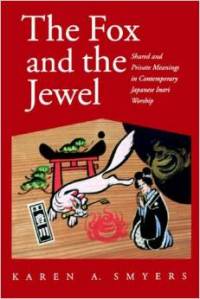 This is perhaps one of the most important books for those interested in Inari worship outside of Japan, and is often included on “must-read” lists for Shinto-related works. It was certainly my primary resource for information about Inari-sama when I was beginning my studies into this deity, and I still think it’s one of the best books I’ve read, not just about Inari-sama or Shinto, but on Japanese religion as a whole.
This is perhaps one of the most important books for those interested in Inari worship outside of Japan, and is often included on “must-read” lists for Shinto-related works. It was certainly my primary resource for information about Inari-sama when I was beginning my studies into this deity, and I still think it’s one of the best books I’ve read, not just about Inari-sama or Shinto, but on Japanese religion as a whole.
One thing this book is keen to stress is, there is absolutely no “standardised” Inari, or way to worship Inari – veneration of this kami varies hugely from region to region, shrine to shrine and individual to individual. In fact, this book highlights that Inari’s nature is very mysterious; despite being one of the most important and popular of the Japanese kami, very little is written about him; he isn’t even mentioned in the Kojiki, the ancient Japanese text about the mythical origins of Japan which includes all the other prominent kami such as Amaterasu and Susanowo. No-one knows if he is male, female, both or neither; if his form is human, snake, dragon or fox (priests discourage the idea of him being a fox but Smyers points out that lay worshippers do occasionally venerate him as a fox, or vice versa), or even if his origins are Chinese or Japanese.
Rather than try to present a “definitive” Inari, Smyers carefully explores the various institutions and symbols surrounding Inari. To look at how Inari is worshipped, she includes two small ethnographies of life in two different Inari shrines (the Shinto Fushimi Inari Taisha and the Buddhist Toyokawa temple), as well as the practices among lay worship groups (ko), shamans and casual individual worshippers. She also pays a great deal of focus on the two most prominent symbols of Inari worship – the fox and the jewel – and attempts to uncover why they are linked to Inari.
Ultimately, many (if not all!) of the questions posed regarding Inari worship in this work remain open-ended, with no firm conclusion as to the deeper meanings of Inari worship. Because Smyers presents so many different possibilities, this is still satisfying. In fact, this book uncovers more truths about Japanese society itself than it does about Inari. As the audience of this work are probably as interested in Japanese anthropology as they are about Inari, this probably isn’t unwelcome.
So what can Pagans who are not necessarily Shintoists take out of this work? Surprisingly, quite a bit. Firstly, Pagans will probably be pleased to know that Inari worship manages just fine without any consensus as to the nature of Inari or the appropriate way to worship her, or indeed a centralised institution or text that issues guidelines on Inari. As a Pagan, I was also delighted to find out how similar ko worship groups are to Pagan moots. Smyers describes how one ko group made offerings to a sacred fire in very much the same way to a typical moot – it reminded me of my own moot Medway Pagans very much.
Finally, I should comment on how this book demonstrates that it is possible to write a serious academic piece and still make it accessible, beautiful and a joy to read. I think I enjoyed reading this more than any other work on either Paganism or Shinto, and look forward to reading it again, which I’m sure I will!
